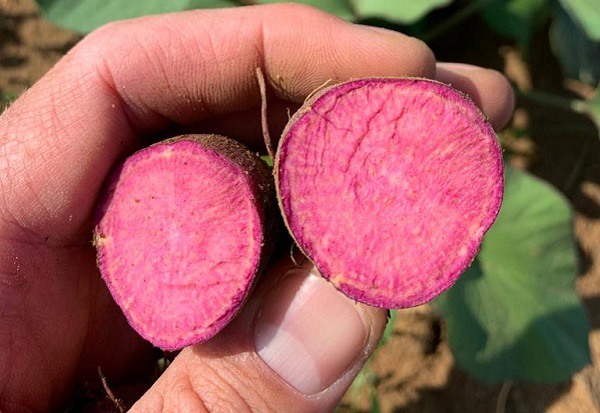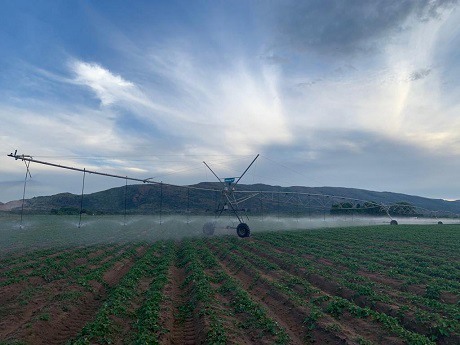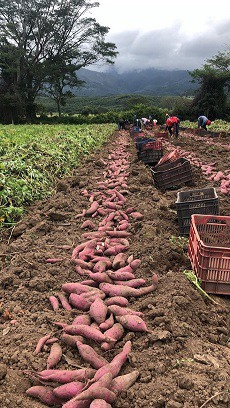The sweet potato market is growing and, for many people, fits in well with a conscious lifestyle diet. They are also a tasty alternative for ‘regular’ potatoes. There are, however, a few more sweet potato varieties than just the orange-fleshed ones. There are white-fleshed sweet potatoes, red and white ones, and even purple ones.

Purple sweet potatoes
It is precisely here, for these varieties, that Rene Rooseman of Dutch produce wholesaler, Bel Impex, sees opportunities in the market. “Consumers have become most aware of the orange sweet potato,” says Rene. “They first appeared in restaurants and, from there, moved to store shelves. In recent years, the sweet potato fries trend has also been added, and you see these popping up in more and more chain stores.”
White-fleshed sweet potatoes
Orange sweet potatoes are the sweetest variety. The other types of sweet potatoes taste milder. “The white-fleshed, and red and white ones - these have a red peel and white flesh - taste milder and are more similar to potatoes. They are, therefore, more suited to replacing the latter in dishes,” adds Rene. “That also makes it easier for people to switch to sweet potatoes. That is especially true for consumers in the European market.”
“Perhaps, particularly for Dutch people, who are more accustomed to regular potatoes. You can see this focus on more diversity in sweet potatoes reflected in the retail sector. Stores are busy repositioning their potato category, and they want to do so by, among other things, being able to offer more sweet potatoes varieties to shoppers. That, while sweet potatoes are not even officially a potato, they are considered to be a vegetable.”
 Sweet potatoes being irrigated on the farm in Honduras
Sweet potatoes being irrigated on the farm in Honduras
Purple sweet potatoes
Then there are also purple sweet potatoes. “This is a rapid climber on the market but, take note, this still concerns modest volumes compared to orange sweet potatoes. Purple sweet potatoes do particularly well in the hospitality industry and often photograph exceptionally well in dishes,” says Rene. “Restaurants, hotels, and caterers, therefore, often use this purple variety as a coloring in desserts. Seeing this, home cooks start using this sweet potato more and more, and that makes for a growing market.”
Market situation
Bel Impex imports most of its sweet potatoes from Honduras. There the company works with a farmer who cultivates this product for their Belicious house brand. “We get sweet potatoes that meet both the GlobalGAP and Social Compliance standards, all year long, from Honduras. We bring these in by ship and have a lead time of about 16 days. That excludes transportation to and from the port and all the necessary checks.”
The United States, with North Carolina as the most important state there, is Europe’s largest export market. “American sweet potatoes are always of good quality. The Americans can harvest these vegetables twice a year and have the facilities to store their sweet potatoes for six months. That means that that country can export sweet potatoes year-round,” Rooseman continues. “China is a major sweet potatoes producer too, but there, export certification is lacking.”
 The hype surrounding this product means European growers are also starting to cultivate sweet potatoes. Acreage has, therefore, been added for this in countries such as Spain. “The season there is, however, still short, and Spanish farmers can certainly not supply this vegetable year-round. Also, the quality is good for half the season and of lesser quality and not consistently the same in the other half.”
The hype surrounding this product means European growers are also starting to cultivate sweet potatoes. Acreage has, therefore, been added for this in countries such as Spain. “The season there is, however, still short, and Spanish farmers can certainly not supply this vegetable year-round. Also, the quality is good for half the season and of lesser quality and not consistently the same in the other half.”
“We only import from Spain if we have no other choice,” explains Rene. “Egypt is another country that is growing more and more sweet potatoes for the export market. The quality is not so good, although I have to say, it improves year-on-year. Our clients then prefer the consistent quality and price of our Honduran sweet potatoes.”
“It is still risky for Europeans farmers to cultivate sweet potatoes because this vegetable is not intended to be grown in extreme conditions. If it is too cold or wet for a few days, the crop will fail. It is, therefore, difficult to say whether there is growth in this market for farmers in Europe.”
“That can make it challenging to supply sweet potatoes to the market throughout the year. Positioning on an evolving market is, however, crucial,” says Rooseman. “Thus, the question is whether European growers can provide sufficient diversity. The coming years could prove to be exciting on the sweet potato market.”
“Especially for organic sweet potatoes cultivation in Europe, where this product is sold at premium prices. You cannot compete with these prices unless the European Union subsidizes you. Conscious living is, therefore, only easily obtained by those people who have a very fat purse,” concludes Rene.
 Bel Impex Nootdorp
Bel Impex Nootdorp
Stoomweg 4
2631 RR Nootdorp
The Netherlands
Telefoon: +31 (0)70 3207574
www.belimpex.nl
rene@belimpex.nl
